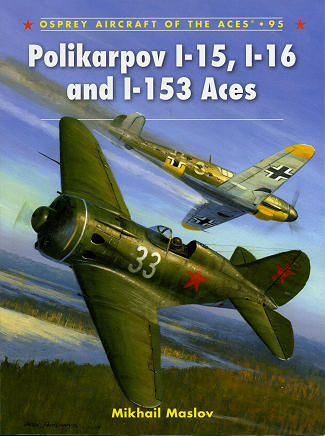 As
many of you know, the Polikarpov line of fighters in the I-15 and I-16 series
were very much cutting edge in the mid-1930s when they first appeared. This is
particularly so regarding the I-16 monoplane that was the envy of other nations
due to its speed and armament. Since the Soviet Union was doing its best to
meddle in the politics of other nations at the time and was very anti-faschist,
it was a natural that they would seek to involve themselves in the Spanish Civil
war. It was here that the I-15 and I-16 were to leave their mark on the world
and it was here that the first aces were made flying this plane against what was
basically the German Luftwaffe.
As
many of you know, the Polikarpov line of fighters in the I-15 and I-16 series
were very much cutting edge in the mid-1930s when they first appeared. This is
particularly so regarding the I-16 monoplane that was the envy of other nations
due to its speed and armament. Since the Soviet Union was doing its best to
meddle in the politics of other nations at the time and was very anti-faschist,
it was a natural that they would seek to involve themselves in the Spanish Civil
war. It was here that the I-15 and I-16 were to leave their mark on the world
and it was here that the first aces were made flying this plane against what was
basically the German Luftwaffe.
But it wasn't only Spain that allowed Soviet pilots to gain
experience and rack up scores. The Japanese were also fought in 1937/1938 under
the guise of helping the Chinese during their war with Japan and again in 1939
during the Nomonhan Incident in Mongolia. In both cases, the Polikarpov fighters
were more than a match for the opposing forces. It was in 1939/40 during the
Winter war with Finland that the skills of opposing pilots was such that the
Polikarpov aircraft were not rulers of the skies. Some made ace against the
Finns, but it wasn't as many as the Soviets had hoped. The time of ascendency
was over and the Polikarpov fighters were becoming obsolescent.
It was during the Great Patriotic War against the Germans
that the Soviet fighter was finally eclipsed. By this time, it was a 7 or 8 year
old design and as such, generally inadequate against the superior fighters of
the Luftwaffe. It doesn't mean that it was totally ineffective as Russian pilots
still were able to rack up a respectable score against mostly bombers and
liaison aircraft, but the venerable planes were being replaced by newer Yaks and
Lavochkins. Still, the aircraft soldiered on in front line duty with some units
until as late as 1944 before being relegated to other tasks.
Author Mikhail Maslov tells us the story of the pilots who
flew these planes and the successes that they had. Some gained all their success
with the stubby Polikarpov fighters while others began their scores flying them.
There are many stories of their successes taken from after action reports that
are very interesting to read. When one combines this with period photographs of
pilots and planes along with the very nicely done profiles by Andrey Yurgenson,
it makes for not only a most interesting read, but a nicely done reference on an
important Soviet aircraft.
It is a book I thoroughly enjoyed reading and can quite
easily recommend to you.
May 2010
For more on the complete line of Osprey books,
visit www.ospreypublishing.com. In the US, it is
Osprey Direct at 44-02 23rd St, Suite 219, Long Island City, NY 11101., where you can
get a catalogue of available books.
If you would like your product reviewed fairly and quickly, please contact
me or see other details in the Note to
Contributors.
 As
many of you know, the Polikarpov line of fighters in the I-15 and I-16 series
were very much cutting edge in the mid-1930s when they first appeared. This is
particularly so regarding the I-16 monoplane that was the envy of other nations
due to its speed and armament. Since the Soviet Union was doing its best to
meddle in the politics of other nations at the time and was very anti-faschist,
it was a natural that they would seek to involve themselves in the Spanish Civil
war. It was here that the I-15 and I-16 were to leave their mark on the world
and it was here that the first aces were made flying this plane against what was
basically the German Luftwaffe.
As
many of you know, the Polikarpov line of fighters in the I-15 and I-16 series
were very much cutting edge in the mid-1930s when they first appeared. This is
particularly so regarding the I-16 monoplane that was the envy of other nations
due to its speed and armament. Since the Soviet Union was doing its best to
meddle in the politics of other nations at the time and was very anti-faschist,
it was a natural that they would seek to involve themselves in the Spanish Civil
war. It was here that the I-15 and I-16 were to leave their mark on the world
and it was here that the first aces were made flying this plane against what was
basically the German Luftwaffe.